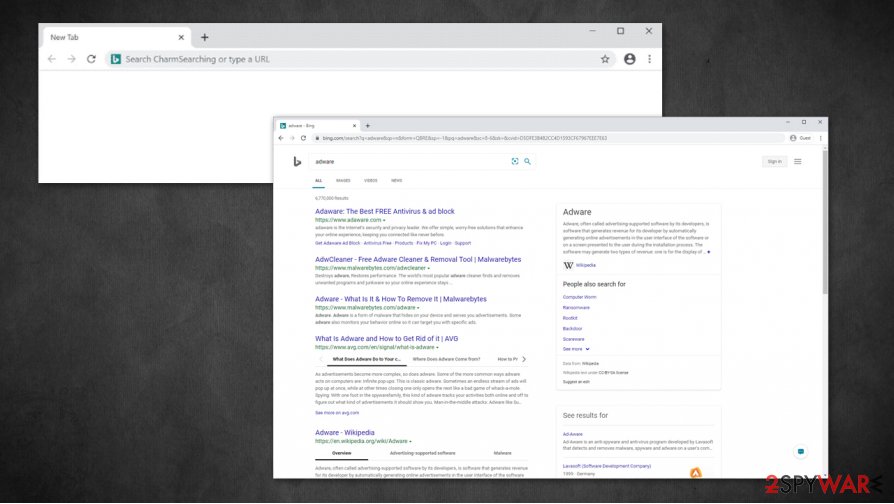Charmsearching (Removal Instructions) - Free Instructions
Charmsearching Removal Guide
What is Charmsearching?
Charmsearching is a Bing redirect virus variant that shows up on browsers seemingly out of nowhere

Charmsearching.com is a search hijacker that started to bother users recently. According to some reports, they noticed a suspicious Google Chrome behavior, in which their searches are redirected through a suspicious web address charmserching.com. Instead of receiving typical results via Google.com or another provider, users are presented with Bing search results.
Search hijacking can be related to various deceptive expansions installed on a web browser. Alternatively, the Charmsearching hijack can also be a consequence of an installed potentially unwanted program.[1] Both of these are usually downloaded along with freeware installers, so users rarely notice the point of entry. To eliminate unwanted behavior, the PUP must be found and deleted from a computer.
| Name | Charmsearching / Charmsearching.com |
|---|---|
| Type | Browser hijacker, potentially unwanted program |
| Distribution | Software bundle packages, deceptive ads, fake update prompts |
| Symptoms | Unknown extension or application is installed on the system; homepage and new tab address are set to something else; a customized search engine is appended to the homepage; search results are filled with sponsored links and ads and are redirected to Bing |
| Risks | Installation of other potentially unwanted programs, privacy risks due to information gathering practices, financial losses |
| Removal | You can uninstall potentially unwanted programs by following the manual guide below or by scanning the computer with powerful anti-malware |
| Optional steps | Computer infections can cause significant damage to system files or disrupt normal settings. To revert these changes and remediate the OS, perform a full system scan with FortectIntego repair software |
There are thousands of browser hijackers similar to the Charmsearching virus. It can affect a wide array of devices, including Windows or Mac computers, Androids, iPhones, Chromebooks,[2] etc. The activity can also be observed on Google Chrome, Mozilla Firefox, MS Edge, Safari, or another web browser.
Most of the unwanted programs are delivered with the help of software bundle packages. Thus, users find suspicious browser changes seemingly out of nowhere. However, some users claimed that Charmsearching.com redirects started to occur seemingly out of nowhere, as they did not download anything on their machines.
The truth is that some browser extensions or applications that previously worked without any problems sometimes go rogue. For example, they might change the ad network delivery service, which sometimes is a change for the worse. In other terms, a program or add-on might sometimes go rogue and begin malicious activity seemingly out of nowhere.
Once inside the machine, the Charmsearching.com virus would change web browser settings behind users' backs – this activity might not always be detected immediately (at least visually). Users might still see suspicious behavior almost straight away – symptoms include, but are not limited to, the following:
- Unknown browser extensions are installed on the web browser;
- Slow web browser operation;
- Overall increased amount of advertisements;
- All searches are redirected to Bing;
- Provided search results are filled with sponsored ads;
- Redirects lead to suspicious websites, etc.
As typical, Charmsearching redirects are established on users' machines for one purpose only – to generate revenue to its developers. As long as the hijacker is present on a computer, users have to deal with ads, redirects, unwanted web browser settings, and other disturbances.

To make matters worse, Charmsearching.com might be gathering a variety of information about users' online behavior. The harvested data might also be shared with unknown third-parties or sold for marketing purposes.
Perhaps the most dangerous traits and one of the main reasons for Charmsearching removal is its ability to redirect. Since the URL is deceptive, there is no way to guarantee that you will not be redirected to malware-laden or scam websites. As a result, you might end up losing money, disclosing personal info, or installing malicious software on your machine.
To remove Charmsearching from your device, you need to locate the potentially unwanted program that is installed on your system. The quickest way would be scanning the device with anti-malware such as SpyHunter 5Combo Cleaner or Malwarebytes and then checking for virus damage with FortectIntego. Nonetheless, security apps might not be able to detect an extension that has gone rogue seemingly out of nowhere, so it is best to delete extensions first and checking if the redirect problem persists.
Avoid annoying browser hijackers
As a general rule, a browser hijacker is not considered a major computer threat by experts,[3] as it does not directly meddle with system settings or drops malicious files. Nonetheless, there have been plenty of potentially unwanted applications and online scams that abuse legitimate features (e.g., push notifications, “Managed by your organization” setting) in order to prolong the presence on the affected device. If anything, hijackers are annoying additions that will change your browser settings and show you ads, whether you want it or not.
Thus, you should do everything to prevent the infiltration of unwanted applications, and for that, you should learn how they spread. One of the most prevalent methods is software bundling, where freeware developers and distributors serve installers compiled of multiple components. These are deliberately hidden from fewer cautions users with tricks such as pre-ticked boxes, misleading button placements, deceptive offers, fine print text, etc.
To prevent the installation of PUPs, never rush the installation process, especially if you choose third-party websites for your downloads. Always opt for Advanced/Custom settings when prompted to stay in control of the process, remove all the ticks from checkboxes, and read the instructions carefully.

Get rid of Charmsearching.com for good
Typically, deleting potentially unwanted programs is easy – all you have to do is to enter an adequate section of your computer (for example, Control Panel on Windows) and look for suspicious applications. If you have never performed program uninstallation before, you can follow our step-by-step guide below to remove Charmsearching manually.
However, likely, the hijack is directly connected to a browser extension that is appended on your web browser. In such a case, Charmsearching removal should be performed by trying to delete each of the extensions one-by-one (you can also delete them all at once, although you will not know which add-on is the culprit).
Finally, you should also scan your machine with powerful anti-malware software to ensure its full security – there is plenty of malware that might be invisible to you and hide behind malicious processes.
You may remove virus damage with a help of FortectIntego. SpyHunter 5Combo Cleaner and Malwarebytes are recommended to detect potentially unwanted programs and viruses with all their files and registry entries that are related to them.
Getting rid of Charmsearching. Follow these steps
Uninstall from Windows
To uninstall unwanted programs from Windows systems, follow this guide:
Instructions for Windows 10/8 machines:
- Enter Control Panel into Windows search box and hit Enter or click on the search result.
- Under Programs, select Uninstall a program.

- From the list, find the entry of the suspicious program.
- Right-click on the application and select Uninstall.
- If User Account Control shows up, click Yes.
- Wait till uninstallation process is complete and click OK.

If you are Windows 7/XP user, proceed with the following instructions:
- Click on Windows Start > Control Panel located on the right pane (if you are Windows XP user, click on Add/Remove Programs).
- In Control Panel, select Programs > Uninstall a program.

- Pick the unwanted application by clicking on it once.
- At the top, click Uninstall/Change.
- In the confirmation prompt, pick Yes.
- Click OK once the removal process is finished.
Delete from macOS
If you are using a Mac, you should eliminate all the suspicious apps as follows:
Remove items from Applications folder:
- From the menu bar, select Go > Applications.
- In the Applications folder, look for all related entries.
- Click on the app and drag it to Trash (or right-click and pick Move to Trash)

To fully remove an unwanted app, you need to access Application Support, LaunchAgents, and LaunchDaemons folders and delete relevant files:
- Select Go > Go to Folder.
- Enter /Library/Application Support and click Go or press Enter.
- In the Application Support folder, look for any dubious entries and then delete them.
- Now enter /Library/LaunchAgents and /Library/LaunchDaemons folders the same way and terminate all the related .plist files.

Remove from Microsoft Edge
Delete unwanted extensions from MS Edge:
- Select Menu (three horizontal dots at the top-right of the browser window) and pick Extensions.
- From the list, pick the extension and click on the Gear icon.
- Click on Uninstall at the bottom.

Clear cookies and other browser data:
- Click on the Menu (three horizontal dots at the top-right of the browser window) and select Privacy & security.
- Under Clear browsing data, pick Choose what to clear.
- Select everything (apart from passwords, although you might want to include Media licenses as well, if applicable) and click on Clear.

Restore new tab and homepage settings:
- Click the menu icon and choose Settings.
- Then find On startup section.
- Click Disable if you found any suspicious domain.
Reset MS Edge if the above steps did not work:
- Press on Ctrl + Shift + Esc to open Task Manager.
- Click on More details arrow at the bottom of the window.
- Select Details tab.
- Now scroll down and locate every entry with Microsoft Edge name in it. Right-click on each of them and select End Task to stop MS Edge from running.

If this solution failed to help you, you need to use an advanced Edge reset method. Note that you need to backup your data before proceeding.
- Find the following folder on your computer: C:\\Users\\%username%\\AppData\\Local\\Packages\\Microsoft.MicrosoftEdge_8wekyb3d8bbwe.
- Press Ctrl + A on your keyboard to select all folders.
- Right-click on them and pick Delete

- Now right-click on the Start button and pick Windows PowerShell (Admin).
- When the new window opens, copy and paste the following command, and then press Enter:
Get-AppXPackage -AllUsers -Name Microsoft.MicrosoftEdge | Foreach {Add-AppxPackage -DisableDevelopmentMode -Register “$($_.InstallLocation)\\AppXManifest.xml” -Verbose

Instructions for Chromium-based Edge
Delete extensions from MS Edge (Chromium):
- Open Edge and click select Settings > Extensions.
- Delete unwanted extensions by clicking Remove.

Clear cache and site data:
- Click on Menu and go to Settings.
- Select Privacy, search and services.
- Under Clear browsing data, pick Choose what to clear.
- Under Time range, pick All time.
- Select Clear now.

Reset Chromium-based MS Edge:
- Click on Menu and select Settings.
- On the left side, pick Reset settings.
- Select Restore settings to their default values.
- Confirm with Reset.

Remove from Mozilla Firefox (FF)
Remove dangerous extensions:
- Open Mozilla Firefox browser and click on the Menu (three horizontal lines at the top-right of the window).
- Select Add-ons.
- In here, select unwanted plugin and click Remove.

Reset the homepage:
- Click three horizontal lines at the top right corner to open the menu.
- Choose Options.
- Under Home options, enter your preferred site that will open every time you newly open the Mozilla Firefox.
Clear cookies and site data:
- Click Menu and pick Settings.
- Go to Privacy & Security section.
- Scroll down to locate Cookies and Site Data.
- Click on Clear Data…
- Select Cookies and Site Data, as well as Cached Web Content and press Clear.

Reset Mozilla Firefox
If clearing the browser as explained above did not help, reset Mozilla Firefox:
- Open Mozilla Firefox browser and click the Menu.
- Go to Help and then choose Troubleshooting Information.

- Under Give Firefox a tune up section, click on Refresh Firefox…
- Once the pop-up shows up, confirm the action by pressing on Refresh Firefox.

Remove from Google Chrome
Delete suspicious browser extensions to attempt to delete Charmsearching issue for good:
Delete malicious extensions from Google Chrome:
- Open Google Chrome, click on the Menu (three vertical dots at the top-right corner) and select More tools > Extensions.
- In the newly opened window, you will see all the installed extensions. Uninstall all the suspicious plugins that might be related to the unwanted program by clicking Remove.

Clear cache and web data from Chrome:
- Click on Menu and pick Settings.
- Under Privacy and security, select Clear browsing data.
- Select Browsing history, Cookies and other site data, as well as Cached images and files.
- Click Clear data.

Change your homepage:
- Click menu and choose Settings.
- Look for a suspicious site in the On startup section.
- Click on Open a specific or set of pages and click on three dots to find the Remove option.
Reset Google Chrome:
If the previous methods did not help you, reset Google Chrome to eliminate all the unwanted components:
- Click on Menu and select Settings.
- In the Settings, scroll down and click Advanced.
- Scroll down and locate Reset and clean up section.
- Now click Restore settings to their original defaults.
- Confirm with Reset settings.

Delete from Safari
Remove unwanted extensions from Safari:
- Click Safari > Preferences…
- In the new window, pick Extensions.
- Select the unwanted extension and select Uninstall.

Clear cookies and other website data from Safari:
- Click Safari > Clear History…
- From the drop-down menu under Clear, pick all history.
- Confirm with Clear History.

Reset Safari if the above-mentioned steps did not help you:
- Click Safari > Preferences…
- Go to Advanced tab.
- Tick the Show Develop menu in menu bar.
- From the menu bar, click Develop, and then select Empty Caches.

After uninstalling this potentially unwanted program (PUP) and fixing each of your web browsers, we recommend you to scan your PC system with a reputable anti-spyware. This will help you to get rid of Charmsearching registry traces and will also identify related parasites or possible malware infections on your computer. For that you can use our top-rated malware remover: FortectIntego, SpyHunter 5Combo Cleaner or Malwarebytes.
How to prevent from getting browser hijacker
Access your website securely from any location
When you work on the domain, site, blog, or different project that requires constant management, content creation, or coding, you may need to connect to the server and content management service more often. The best solution for creating a tighter network could be a dedicated/fixed IP address.
If you make your IP address static and set to your device, you can connect to the CMS from any location and do not create any additional issues for the server or network manager that needs to monitor connections and activities. VPN software providers like Private Internet Access can help you with such settings and offer the option to control the online reputation and manage projects easily from any part of the world.
Recover files after data-affecting malware attacks
While much of the data can be accidentally deleted due to various reasons, malware is one of the main culprits that can cause loss of pictures, documents, videos, and other important files. More serious malware infections lead to significant data loss when your documents, system files, and images get encrypted. In particular, ransomware is is a type of malware that focuses on such functions, so your files become useless without an ability to access them.
Even though there is little to no possibility to recover after file-locking threats, some applications have features for data recovery in the system. In some cases, Data Recovery Pro can also help to recover at least some portion of your data after data-locking virus infection or general cyber infection.
- ^ Chris Hoffman. PUPs Explained: What is a “Potentially Unwanted Program”?. How-To Geek. Site that explains technology.
- ^ Charmsearching. Reddit. Social network.
- ^ Dieviren. Dieviren. Cybersecurity advice and malware insights.























